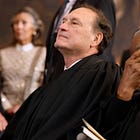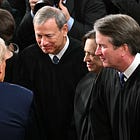The worst chief justice of all time
Move over, Roger Taney and Melville Fuller.
🗣️ Paid subscribers make Public Notice possible. If you appreciate our fiercely independent coverage of American politics, please sign up and support us. 👇
American history has no shortage of legendarily bad chief justices and disgraceful decisions. But Chief Justice John Roberts has overseen the wholesale corruption and capture of the Supreme Court, and history should look back on his tenure with revulsion.
This isn’t about whether there are individual cases from the past that are worse than any individual Roberts-era decision. It’s that compared to previous chief justices, the entire arch of the Robert Court has been about enshrining discrimination into law and protecting the powerful at the expense of the powerless.
The Taney Court
When people talk about the worst Supreme Court era, they’re often talking about Chief Justice Roger Taney, who headed the Court from 1836 to 1864. Taney wrote the majority opinion in Dred Scott v. Sandford, the 1857 case widely considered to be the Supreme Court’s most shameful decision.
Taney’s brazenly racist opinion said that a Black person whose ancestors were brought to the United States and sold into slavery could never be an American citizen. The majority also held that enslaved people were property, and because the Fifth Amendment forbids deprivation of property without due process, Congress could not ban slavery in the federal territories.
If the Taney Court had only given us Dred Scott, that alone would be enough to stain Taney’s tenure forever. But that decision built upon several previous Taney-era cases that laid the groundwork for the comprehensive dehumanization of Black people found in Dred Scott.
Fifteen years previously, the Taney Court had decided Prigg v. Pennsylvania. The majority overturned a Pennsylvania law prohibiting the extradition of Black people to other states to enslave them. The Court held the law was unconstitutional under Article IV, Section 2, the Fugitive Slave Clause. Only Congress, the Court said, could pass laws about the return of fugitives.
In 1847’s Jones v. VanZandt, John VanZandt, an abolitionist, argued that slavery was unconstitutional. Nope, said the Taney Court. Slavery was a “political question, settled by each state for itself,” and one of the “sacred compromises” of the Constitution was that it protected the institution of slavery so that Southern states would remain in the Union. Taney’s majority opinion four years later in Strader v. Graham said the Court had no jurisdiction to review a Kentucky court’s determination that time spent in Ohio, a free state, did not change the status of the enslaved men because that court’s ruling was based entirely on Kentucky state law.
Taney also mused that when new states formed, they had the right “to be admitted into the Union upon an equal footing with the old states.” The “old states” he’s talking about here are the original 13 states, which were able to choose to have slavery. Gotta give every new state a chance to become a slave state, for freedom.
A note from Aaron: Enjoying this article from Lisa? Then please sign up to support our work 📈 Paid subscribers keep PN free for everyone 📈
Taney died in October 1864, about six months before the end of the Civil War. Between 1865 and 1870, the Reconstruction Amendments were ratified. The Thirteenth Amendment abolished slavery. The Fourteenth Amendment extended citizenship to formerly enslaved persons and their descendants and established the right to equal protection under the law. The Fifteenth Amendment guaranteed the right to vote, regardless of race or previous enslavement.
These amendments undid much of the Taney Court’s work of justifying and propping up slavery. Indeed, the Fourteenth Amendment’s citizenship guarantee overturned Dred Scott. But by 1877, the Reconstruction era had ended, and with it much of the efforts to protect the rights of Black people.
The Fuller Court
Chief Justice Melville Fuller, who helmed the Court from 1888 to 1910, was no slouch at ensuring the Court supplemented its commitment to racism with an equally fervent commitment to economic exploitation.
The Fuller Court is responsible for the spiritual successor to Dred Scott, Plessy v. Ferguson. Sure, the Fourteenth Amendment required equal treatment under the law, but Plessy upheld a Louisiana law requiring separate train cars for Black people anyway. State-mandated segregation was perfectly fine as long as things were separate but equal, giving official sanction to Jim Crow laws.
Seven years later, in Lone Wolf v. Hitchcock, a unanimous Court ruled Congress could unilaterally break treaties with Native American tribes and give reservation land to non-Natives instead. The opinion said Native Americans were “wards of the nation” and “dependent on the United States,” and because of that, “there arises the duty of protection, and with it the power.”
A significant project of the Fuller Court was ensuring “economic liberty” by striking down laws meant to protect workers under the guise of “freedom to contract.” 1905’s Lochner v. New York overturned a state law barring bakers from working over 60 hours per week or 10 hours per day. The central conceit of the opinion was that workers were just as harmed by the law because it restricted their ability to contract with their employer. This requires believing in the fiction that employees and employers have equal power and employees can easily negotiate the terms of their employment.
That same fiction informed 1908’s Adair v. United States, which struck down a federal law prohibiting employers from firing people for participating in a labor union. Both sides were harmed, per the Court, because it imposed conditions on the buying and selling of labor. Of course, it isn’t at all clear how an employee would benefit from the freedom to be fired for joining a union.
It’s not terribly hard to see the throughline from the Taney Court’s refusal to see Black people as fully human to the Roberts Court’s much more varied attacks on civil rights.
The case for Roberts (derogatory)
In Roberts’s 20 years atop the Court, conservatives have rolled back the already meager protections for LGBTQ people, making sure to finish the most recent term by kicking trans kids in the teeth. Reproductive rights have been comprehensively gutted, from allowing private for-profit companies to invoke religion to refuse to provide birth control coverage to overturning the constitutional right to abortion. Also, racism is apparently completely fixed, so school desegregation and affirmative action had to go. So too did the core of the Voting Rights Act, letting Roberts fulfill his lifelong ambition of making it harder for Black people to vote.
There’s an obvious connection between the Fuller Court’s fiction that workers and employers have the same amount of power and the Roberts Court’s open and obvious goal of tilting the playing field toward employers. More workers are being forced to agree to arbitration, which strongly favors employers, and waive their right to bring class actions. Public sector unions are now barred from collecting fair share fees, undercutting their ability to bargain collectively. But don’t worry: per Justice Samuel Alito, that’s totally fine because of the “considerable windfall that unions have received.” Roberts spared America the tyranny of a requirement that agriculture companies allow labor organizers to come onto their property, saying that such a requirement was a “taking” by the government for which the employers needed to be compensated.
If the current Court had limited itself to the frequent conservative projects of dismantling civil rights and protecting big business, John Roberts might not get the nod as Worst Chief Ever. But the Roberts Court boasts two additional features that make it an unmatched threat to democracy. First, the conservatives on the Court have gleefully abandoned any pretense of rigorous legal analysis or consistency with past decisions. That’s why you see those justices repeatedly mischaracterizing and omitting facts, shaping the narrative to fit their preferred outcome. It’s why the Court keeps doing this little trick of “stealth reversals,” where they overrule precedent without saying they are doing so, though to be fair, John Roberts loves openly overturning precedent when he feels like it.
Second, those same conservatives have also gleefully abandoned any pretense of checking or balancing the executive branch, instead letting themselves become a rubber stamp for Donald Trump’s worst excesses. That was inevitable after the sweet immunity deal Roberts gave Trump to wipe out his staggering amount of criminal charges. Since the start of Trump’s second term, the Court has routinely allowed the administration to implement objectively unconstitutional actions by pretending that they’re simply making a narrow procedural ruling rather than blessing Trump’s wholesale destruction of democracy. The Court has also gone to war with the lower courts, stepping in again and again to block rulings against the administration.
The nation has faced, many times, a conservative Court aligned with bigotry and big business. But the nation has not previously faced a conservative Court aligned with helping the president become a king. The Roberts Court will go down in history as an exceptional Court, though probably not quite in the way John Roberts expects.
That’s it for today
We’ll be back with more tomorrow. If you appreciate today’s newsletter, please do your part to keep Public Notice free by signing up for a paid subscription.
Thanks for reading, and for your support.







And let’s not forget Roberts bold … and highly hypocritical … statement the “Justice is colorblind” while stripping said color of most advances allowed by the Civil Rights and Voting Rights Acts.
You could add in the frequent use of the shadow docket by the Roberts court, which allows the majority to hide behind their partisan decisions without providing an explanation.